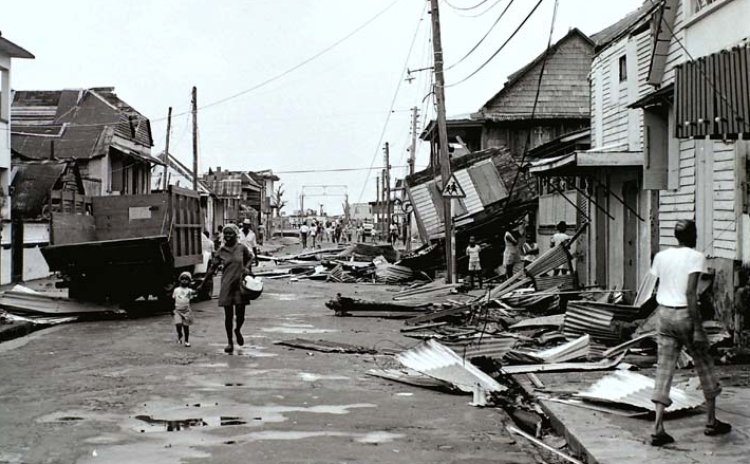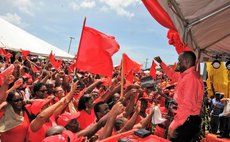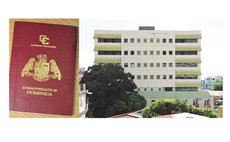Hello, David; we will NOT miss you

On Saturday August 29, Dominicans, especially those over fifty, will remember this extremely traumatic weather event 41 years ago that totally transformed the Dominican landscape.
As we recall the destruction that Hurricane David, this category 5 hurricane caused, we submit that the sores of David had not completely healed when another category five hurricane, Maria, tore these wounds open.
We would, therefore, contend that the lessons that this country ought to have learnt from these two mega-storms (Hurricane David on August 29, 1979 and Hurricane Maria on 18 September, 2017) have not been heeded.
As we have said in earlier editorials, Dominicans continue to display a harmful level of complacency to catastrophe after catastrophe. We care so little, we take things for granted so much that it appears that we like it so.
Environmentalists and disaster risk professionals offered the same analysis after Hurricane David devastated Dominica 41 years ago, that we are unprepared for any type of natural disaster. Tropical Storm Erika was not even a hurricane yet it caused more than $1 billion in damage to the country's infrastructure including Douglas-Charles, Dominica's main airport. In addition, the country's struggling economy was crippled for many years. A once-thriving village, Petite Savanne, was abandoned and the people moved to Bellevue Chopin, a village many miles away.
Although it can be argued that the physical scares of Hurricane David have somewhat healed after 41 years, we believe that Dominica has not effectively learnt the lessons that it should from the ordeal. Undoubtedly, the island is still as vulnerable as it was on 29 August 1979.
On that day, one year after the island attained political independence from Britain and three months after the Patrick John government was violently overthrown, David, a category five hurricane packing winds of 150 miles per hour and carrying millions of gallons of rain, slammed into the island. David striped trees from mountains and smashed homes to smithereens. After pounding Dominica for more than six hours, 56 people died, more than 180 were injured and 75 percent of the population were homeless. For many months after David, hundreds lived in tents in the Botanic Gardens or elsewhere; or boarded-and-lodged with more fortunate friends and relatives.
Most significantly, the winds of David virtually blew away Dominica's economy. Roads and bridges were destroyed; almost every banana plant was broken; coconuts and other fruits littered the ground. Thankfully, many countries came to the aid of our distressed country. After two months, the Interim Government of Oliver J. Seraphine announced that it had received pledges of US$37 million mainly from the United States, Britain, Canada and other Caribbean countries. Apart from the physical damage, one of the more lasting impacts of Hurricane David was the massive exodus, in the wake of the storm, of the country's human recourse especially young, educated and trained members of the work force. That haemorrhaging is still being felt 41 years after and that internal bleeding was made worse by Hurricane Maria in September 2017.
The point we need to stress here is that given the severe pain that David inflicted and the extremely high cost of natural disasters, one would expect the government and its people would plan more adequately because we do not exaggerate when we say that the threat of being devastated by another major hurricane or tropical storm is as real as tomorrow.
As we stated earlier, long before Erika and Maria struck, architect Severin McKenzie told us that he believed that Dominica needed to go beyond the antiquated approach of having people meeting in disaster relief committees. "If you know your house is not strong enough, before a hurricane you can strengthen it. So be proactive and retrofit your house. We are not moving in this direction at all," McKenzie said.
In other words McKenzie suggested that we are not taking adequate measures to reduce the cost of disasters.
One glaring example of this laissez faire attitude towards disaster risk mitigation can be found in the agriculture sector, one of the most important to the local economy. Note that there is no national farm insurance scheme since the demise of WINCROP more than four decades ago. Year after year thousands of entrepreneurs who have invested millions watch their investments blow away.
We ask: why haven't Dominican farmers joined forces with their counterparts in the sub-region to organise a suitable insurance scheme for the sector?
Why haven't institutions, like the Inter-American Institute for Cooperation on Agriculture (IICA) advised governments of the region that the absence of an insurance scheme for farming is one of the most significant issues constraining the development of the sector?
Why haven't farmers and farmers organisations told politicians that one of the most important ways of building resilience in agriculture is an insurance scheme and that politicians must organise it now, or else?
Based on discussions with persons who are familiar with the state of Dominica's preparedness for natural disasters, we have concluded that although Dominicans are unquestionably more aware of the occurrence and consequences of hurricanes and tropical storms, due to the mass media and the internet, the country is as under-prepared for a major disaster as it was before Hurricane David in 1979.




